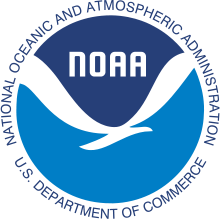 National Oceanic and Atmospheric Administration seal | |
| Agency overview | |
|---|---|
| Formed | 1841 |
| Headquarters | Silver Spring, Maryland, U.S.[1] |
| Motto | OAR's Vision is to deliver NOAA's future. OAR's Mission is to conduct research to understand and predict the Earth's oceans, weather and climate, to advance NOAA science, service and stewardship and transition the results so they are useful to society. |
| Agency executives |
|
| Website | research.noaa.gov |

Oceanic and Atmospheric Research (OAR) is a division of the National Oceanic and Atmospheric Administration (NOAA). OAR is also referred to as NOAA Research.
NOAA Research is the research and development arm of NOAA and is the driving force behind NOAA environmental products and services aimed at protecting life and property and promoting sustainable economic growth. Research, conducted by programs within NOAA and through collaborations outside NOAA, focuses on enhancing the understanding of environmental phenomena such as tornadoes, hurricanes, climate variability, changes in the ozone layer, El Niño/La Niña events, fisheries productivity, ocean currents, deep sea thermal vents, and coastal ecosystem health.
The origins of NOAA Research date to the creation of the Survey of the Coast (renamed the United States Coast Survey in 1836 and the United States Coast and Geodetic Survey in 1878) by President Thomas Jefferson in 1807 and to the creation in 1841 of the United States Lake Survey. The Coast Survey was created to conduct hydrographic surveys of the coastline of the United States, while the Lake Survey was created to undertake "a hydrographic survey of northwestern lakes," i.e, the Great Lakes. Research executed by the scientists of the Lake Survey was innovative and holistic: the first current meters were developed to understand water flow rates, and forecasting techniques were greatly enhanced to predict water levels and the relationship to lakefront property.
The science and technology that NOAA Research produces is not only relevant to society, it anticipates and responds to partners' needs to demonstrates the value of technologies so that partners can deploy them into their applications. OAR works with end-users to integrate mature technologies (and associated expertise) into larger systems, either in NOAA operations or partner applications, via testbeds, patents, etc.
